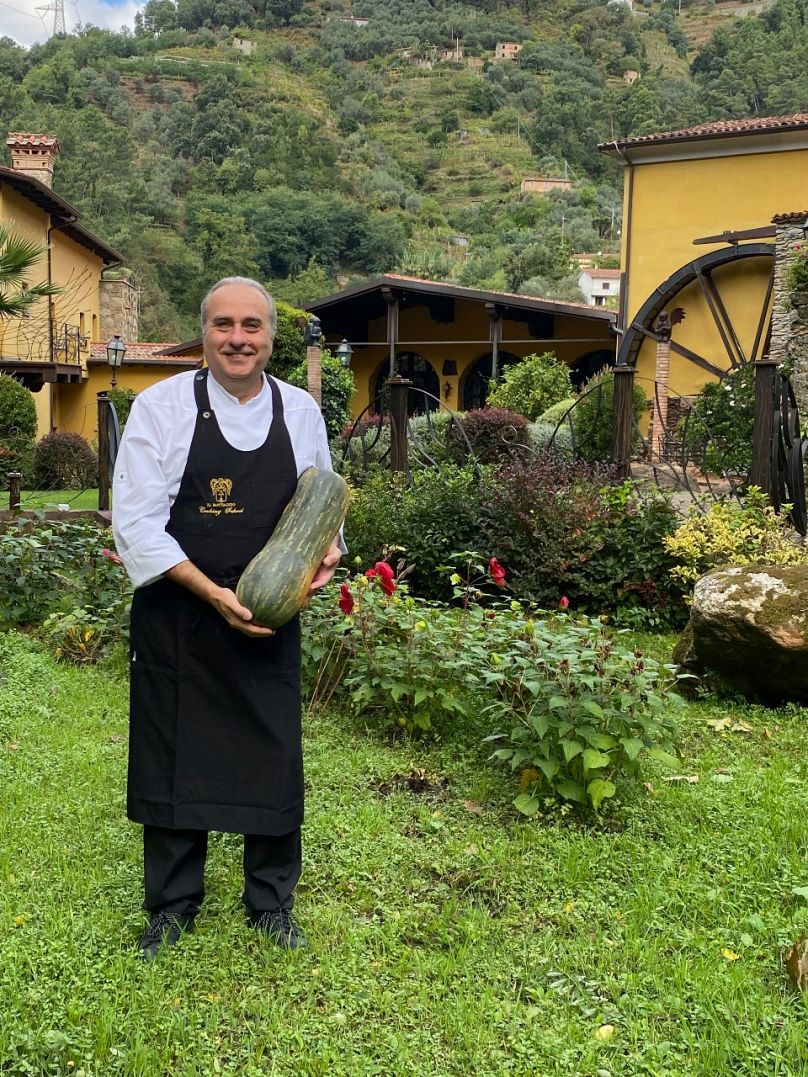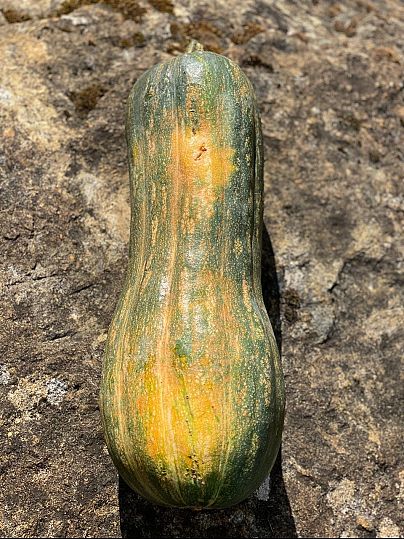In the Neapolitan dialect, pumpkin is called Cocozza (from Latin Cucutia) and there is a variety called Zucca Lunga Napoletana (Cucozza Zuccarina, in dialect) which has a characteristic sweet and musky taste.
 ADVERTISEMENT
ADVERTISEMENT
Nino Mosca is an Napolitan chef and maitre de maison of Relais & Chateaux Il Bottaccio in the heart of Tuscany, Italy. He shares with The Kitchen a Neapolitan autumn classic, Pasta and Cocozza (Pasta and Pumpkin). Hi dubs his version the "five-Ps Pasta": pumpkin, peperoncino, parsley, parmigiano and pepper.
In Neapolitan cuisine, a centenarian tradition passed from one generation to another, the pasta section is very long.
In Napoli, everything is cooked with pasta: Pasta e Fagioli (pasta and beans) Pasta e Ceci (pasta with chickpeas) Pasta e Patate (pasta and potatoes), Pasta e Lenticchie (pasta with lentils), Pasta e Piselli (pasta and peas) the list goes on. A little less known autumn-winter variation is Pasta e Cocozza (Pasta and Pumpkin).
Nino Mosca's Five-Ps Pasta and Cocozza
Cooking time: 30 minutes
Serves: 4
Ingredients
- 500 g long Neapolitan pumpkin or yellow pumpkin, peeled and seeded.
- 300 g of tubular pasta, such as Mezzi Occhi di Lupo or Rigatoni.
- 2 garlic cloves, peeled.
- 4 tablespoons of parsley, chopped.
- ¾ cup (a cup is an American measurement equal to 250 ml) Parmesan cheese, plus more for serving.
- 4 tablespoons of extra virgin olive oil
- Salt and pepper to taste.
- Peperoncino (chilli pepper), optional but highly advised.
(All side P’s, peperoncino, parmesan, parsley and pepper, are fundamental to the dish.)
Method
- "Scocozzare" the pumpkin (that is to remove the skin and the seeds), then cut it into cubes of about 2 cm.
- In a large pot, sauté the full pieces of garlic and chilli pepper (if using). Once golden, remove the garlic and add the pumpkin, stirring for two minutes.
- Now add enough water needed to generously cover everything. When it comes to the boil add some salt. Cook for at least 15 minutes, until the vegetable is well cooked.
- Remove two cups of the cooked pumpkin from the pot and mix in a blender.
- Now cook your pasta in the same pot (with the remaining pumpkin). Halfway through the cooking (check package instructions for the cooking time until al dente), add the blended pumpkin cream into the pot. Continue to cook pasta until al dente. If necessary, add more water (hot water) to reach the desired creaminess (it should look like a good risotto). Finally, add the chopped parsley and grated Parmesan cheese. Mix well, add salt and pepper, to taste, and serve on a soup plate with some more parmesan.
Tip
To enrich the flavour of the dish, nonna Maria (Mosca's grandmother) has a trick: heat a pan over medium heat and add 2 tablespoons of extra virgin olive oil, add a spring of rosemary and let it fry for a few minutes, without letting the spring burn. Now you have rosemary-flavoured oil. Pour a teaspoon of it over the plate of pasta: the sweetness and aromas of the dish will guide you in this autumn journey with the five-Ps flavours.
History
During one of my travels to the US to visit my family, one night I needed to improvise dinner. I opened the pantry for inspiration and I saw a pumpkin. I remembered the old recipe of nonna Maria, who like a good Neapolitan, cooked everything with pasta.
Americans are used to using pumpkin almost exclusively for desserts. So my American family was perplexed when I said I would use it for a pasta dish.
The fact that only one pot and a few ingredients were needed, generated an even higher expectation.
The result was greatly praised, so much so that till this day I receive pictures of Pasta e Cucozza cooked from across the Atlantic Ocean.
For the preparation, nonna Maria used the only pasta she knew well: Spaghetti. Nevertheless, according to tradition, legumes or vegetables must be paired with short pasta shapes (fusilli, penne, orecchiette, farfalle).
But for my nonna Maria, short pasta types were out of the question, and she would also use spaghetti. How? Breaking the spaghetti into 5 parts. I could have measured with a calliper every single piece of spaghetti, and I am sure I would not have found one longer or shorter than the other.
Today, having refined the technique, but without changing the basic ingredients of the traditional recipe, I use a special format of Pasta di Gragnano IGP called "Mezzi Occhi di Lupo," which is very close in shape to the big Neapolitan tubes. Pasta di Gragnano IGP is a dry pasta obtained from a mixture of durum wheat flour and water from Gragnano, near Naples
Due to the presence of cavities in the Mezzi Occhi di Lupo pasta, the shape is ideal to collect the creaminess of the pumpkin sauce.












